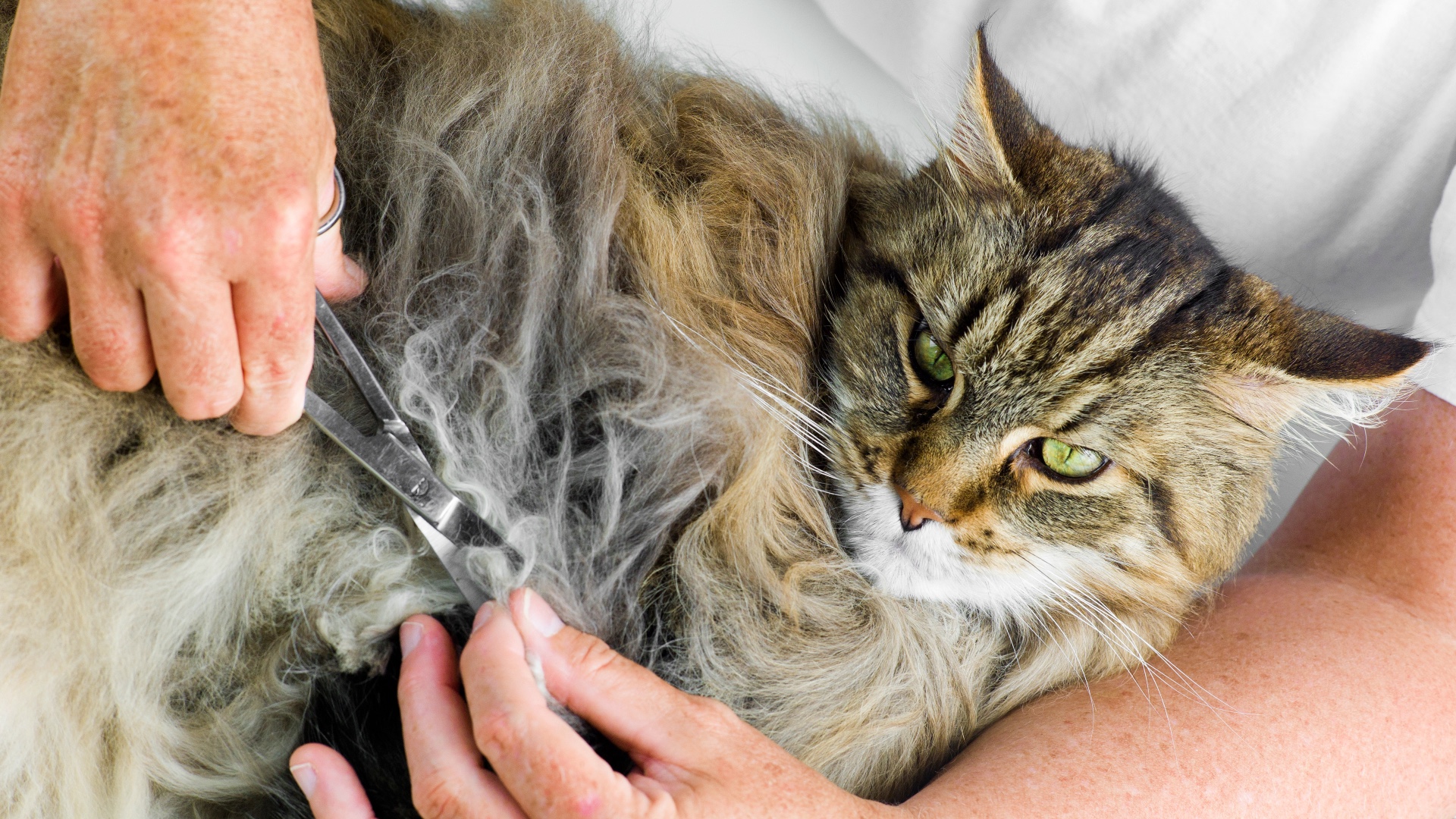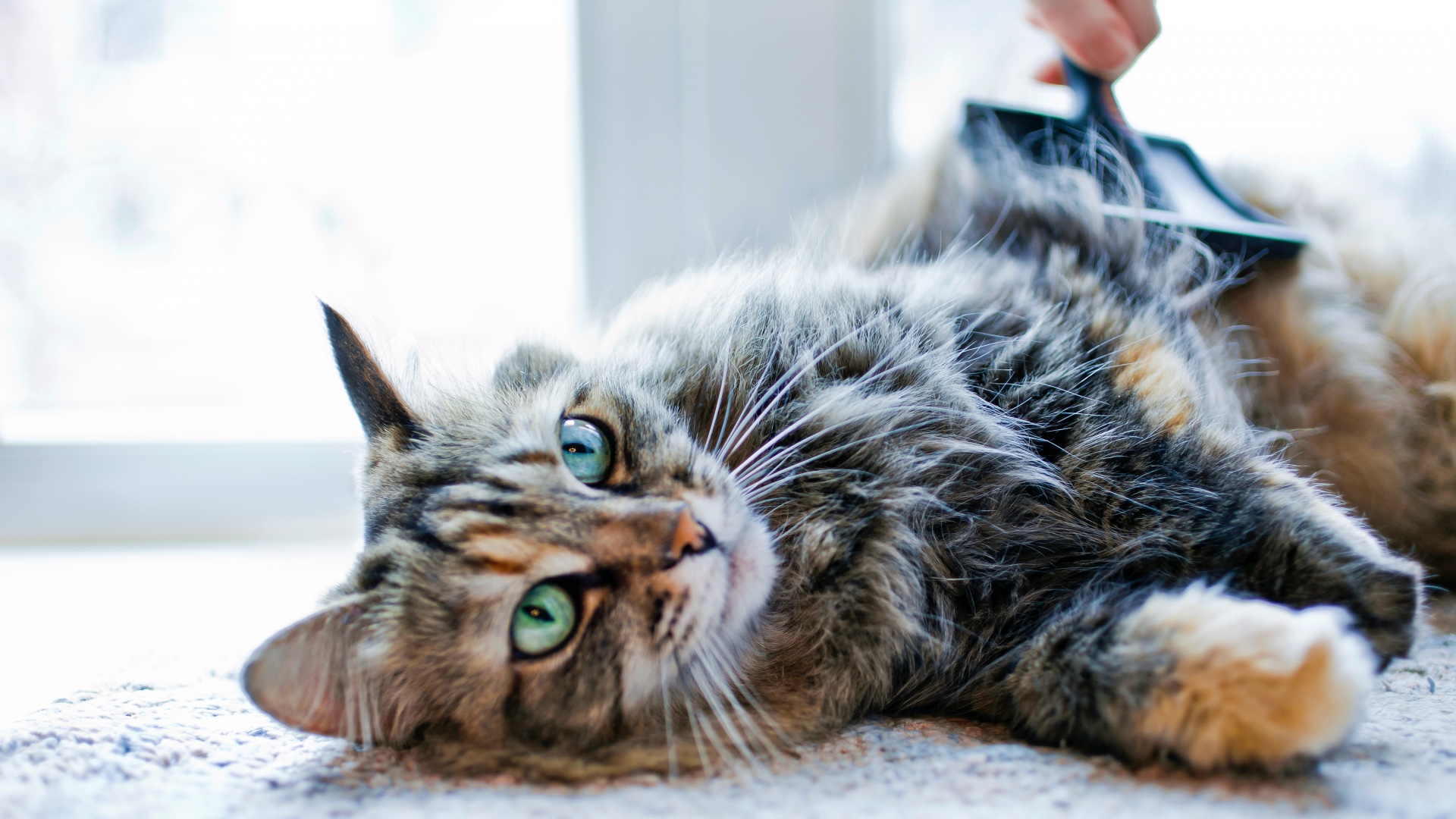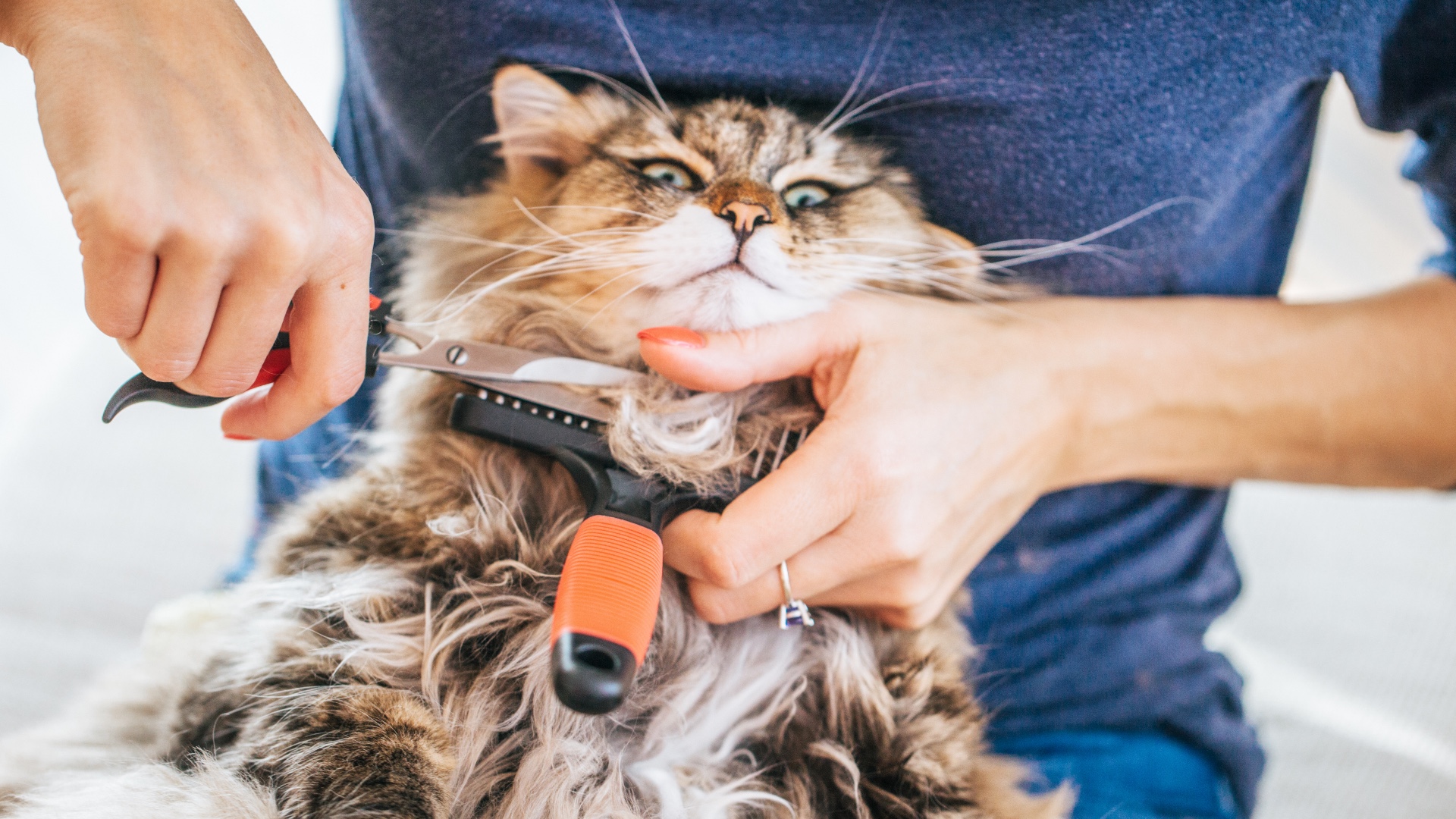How to prevent and treat matted cat fur
From the causes of matted cat fur to how to remove it, this guide has everything you need to know to get your kitty's coat back to looking its best

While our feline furkids are meticulous groomers, given the average cat has around 130,000 hairs per square inch of their body, it’s no surprise that matted cat fur can still happen from time to time, especially in long-haired breeds who are more prone to knots and tangles.
Cats are one of the most hygienic animals on the planet, spending roughly five hours of their day grooming and cleaning themselves. But even with all that attention being lavished on their coat with their rough sandpapery tongue, matted fur can still occur.
And while mats can look unsightly, it goes far beyond a purely cosmetic issue. Matted fur can also cause your kitty a great deal of discomfort and pain as mats prevent oxygen and moisture from reaching the skin, which can lead to dryness and irritation.
Matted fur at the rear end of your cat is also problematic, as it’s not uncommon for urine and feces to become trapped in that area, leading to serious infections that require treatment. Thankfully, regular love and care with one of the best cat brushes alongside their own daily grooming can help keep your kitty’s skin and coat healthy.
Below you’ll find everything you need to know about matted cat fur, including the most common causes, some simple steps you can take to prevent it from happening, and how to de-mat your cat if matting is already an issue.
What causes matted cat fur?
Typically occurring in long-haired and fluffy cat breeds, matted fur is a result of the hair becoming knotted and entangled. There are several reasons why this might happen, with one of the most common being that hair shed from the undercoat can get stuck in the top coat.
This isn’t so problematic if your cat’s skin tends to be on the drier side, as the hair from the undercoat is more likely to fall through without becoming trapped. However, if your kitty’s fur is dirty or oily, this can cause the loose hair to become entwined and stuck together.
Matted fur can also be caused by movement and tends to occur in areas of high friction, which is why a lot of cats will experience it between their hind legs and under their collar.
Finally, a change in your cat’s grooming habits can also cause matted fur. This is most likely in senior cats, who may have mobility issues or joint pain that makes cleaning themselves more challenging, or those who are going through a period of ill health, where they simply don’t have the energy to groom.
4 ways to prevent matted cat fur

Before we look at how to remove mats from your kitty’s fur, it’s worth remembering that prevention is always better (and far less painful!) than cure.
With that in mind, here are a few things you can do to help stop your cat’s fur from becoming matted in the first place.
1. Keep a close eye on your long-haired feline friend
If you have a Persian, Maine Coon, Birman, Ragdoll, Himalayan or other long-haired or fluffy cat breed, you’ll want to do regular checks of their coat. Because they have very soft hair, it’s also prone to static, which means it can tangle a lot easier than the hair on shorter-haired breeds.
We recommend doing a quick sweep of your cat’s coat every few days, paying particular attention to areas that are prone to knotting. Check the armpits, chest, around the neck, and the rear end and if you spot any tangles, deal with them quickly to prevent them from getting worse. A gentle brush will work wonders for mild mats.
2. Monitor your cat’s daily grooming habits
Remember that most cats spend around five hours a day grooming, so if you notice your feline friend spending a lot less time on their usual daily hygiene practices or they’ve stopped altogether, it’s worth taking them to the vet for a checkup.
Changes in grooming habits in older cats may be the result of painful conditions, such as arthritis, which can make turning around to clean certain parts of their body very difficult. In younger cats, a reluctance to groom could signal an underlying health condition.
Even if you’re out during the day and you’re unable to monitor your cat, you’ll be able to detect that their grooming time has been reduced if their coat looks a lot duller than it usually does.
3. Make sure you’re using the correct grooming tools
Grooming a long-haired cat requires a different set of brushes than you’d need if you had a short-haired breed and investing in the right ones will help make the job a lot easier for you.
A long-tooth comb is well worth having in your grooming kit as these penetrate deep into your cat’s fur and can help you deal with small mats before they get out of hand. We also recommend purchasing both a rake and a slicker brush, as these have bristles that do a good job with dense and long hair.
Always start with the comb first, as this can help tease out the tangles and you can also use your finger and thumb to gently work the mats out. You can then finish with a brush to add a nice glossy shine.
4. Groom your cat regularly
Although healthy cats are incredibly independent with their grooming routines, long-haired and fluffy cats do require a little extra help that short-haired breeds don’t need.
Ideally, incorporating a daily brushing session into the day is a great way not just to keep on top of mats, tangles, and knots, but it can also be the perfect way to bond with your kitty by spending some quality time together.
How to de-mat a cat

Before you begin, it’s worth noting that de-matting your cat is unlikely to be a very fun experience for either of you, but with a little bit of knowledge, you can make it as pain-free as possible. Here’s what to do:
1. Get all your tools together
The first thing on the list is to make sure you have everything you need close at hand, including:
- Blunt-ended scissors
- A fine-toothed comb
- A spray bottle containing water and conditioner
- Cornstarch or talcum powder
It’s also worth having some of the best cat treats on hand so you can reward your kitty for staying calm and relaxed.
2. Prep the area
Before you start trying to work the mat out, sprinkle some cornstarch or talcum powder onto it and gently work the mat with your fingers, pulling it up and away from the skin. Throughout this process, talk to your cat in a soothing tone and reward them with a treat. If at any point they get stressed, stop the process and then try again.
3. Cut the mat
Once you’ve pulled the mat up enough that the skin underneath is visible, it’s safe to start cutting. Use blunt-nosed scissors to avoid injuring your cat but make sure they’re sharp enough to cut the mat off quickly and cleanly. Hold the scissors perpendicular to the skin and slide across until you reach the mat. Cut in an upwards direction, being careful not to pull the hair. Repeat the process until all the mats have been removed.
4. Treat small tangles
After cutting out all the mats, you’ll also want to attend to any tangles that haven’t yet matted by spraying them with conditioner mixed with water and gently combing them through until all the hair is free.
If your cat has severely matted fur, we don’t recommend trying to deal with this yourself at home. Instead, make an appointment to see your vet, who’ll be able to advise you on the best course of action.
Seen matted cat fur accompanied by dampness or oozing? Read about how hot spots in cats develop.
PetsRadar Newsletter
Get the best advice, tips and top tech for your beloved Pets

Kathryn is a freelance writer who has been a member of the PetsRadar family since it launched in 2020. Highly experienced in her field, she's driven by a desire to provide pet parents with accurate, timely, and informative content that enables them to provide their fur friends with everything they need to thrive. Kathryn works closely with vets and trainers to ensure all articles offer the most up-to-date information across a range of pet-related fields, from insights into health and behavior issues to tips on products and training. When she’s not busy crafting the perfect sentence for her features, buying guides and news pieces, she can be found hanging out with her family (which includes one super sassy cat), drinking copious amounts of Jasmine tea and reading all the books.
